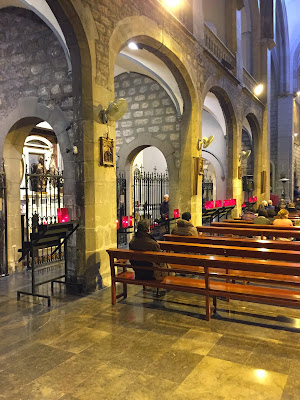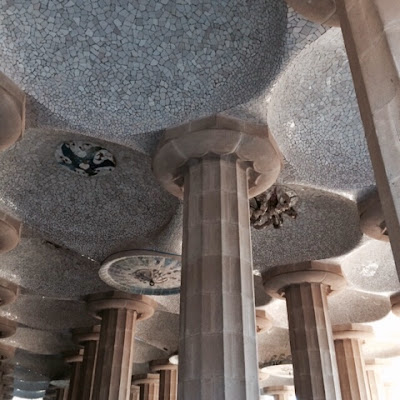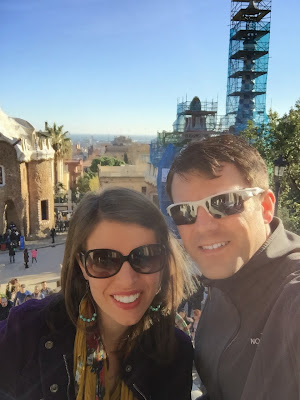Day 1: Sunshine, Here We Come!
Cyle enjoyed an extra long Christmas holiday (he was off from December 20-January 7) thanks to the Swedish holiday schedule, so after the New Year's, we packed up and headed to Barcelona for a few days. We were wanting to at least enjoy some sunshine and we were hopeful for warmer weather. We woke up at 4 am ( I would say at the crack of dawn but the sun doesn't rise in Sweden until 8:30ish) to catch our 6:45 flight to to Barcelona. It was an early morning, especially for Belle who likes to sleep until 10 a.m.!
After we arrived in Barcelona, we went to straight to our hotel. We decided to stay at the hotel Petit Palace, which was located directly off of the Las Ramblas. It was a conveniently located hotel that was close to everything.
Unfortunately, we arrived several hours before check-in, so our room wasn't ready. They offered to store our suitcases until check-in. We took advantage of the opportunity and left to start exploring the city. We were all starving, weren't sure where to go for lunch, so we went with an American standard- McDonald's.
After getting some lunch, we walked around and explored the city. Below are a few pictures of the things we saw:
We were told by friends, our cab driver and the clerks at the hotel to protect your bags as pick pocketing is a major problem on the Las Ramblas. Fortunately, we never had an incident.

The government building of Catalonia. Catalonia is an autonomous community in Spain that even has its own president. The capital of Catalonia is Barcelona
 |
| The Plaça Reial in Barcelona is a popular square just off the Ramblas. It has lots of restaurants and cafes. We ended up going there twice for dinner. |
 |
| The typical Spanish delicacy of churros y chocolate. The hot chocolate is so thick that it is served with a spoon, but it's great for dipping churros. |
By this time, our hotel room was ready, so we headed back for an afternoon siesta! After naps, we went out in search of dinner.
Day 2: Park Güell
We woke up and headed out for full day of sightseeing. Breakfast was provided at our hotel with lots of Spanish delicacies, but Belle decided to go for her usual of yogurt.
After checking the weather and seeing the forecast for the low 60's, we opted to wear light jackets instead of our heavy winter coats. However, when we got out on the streets of Barcelona, I was second guessing that decision as people were bundled up like I would be in Stockholm. Instead of light jackets, people had on hats, mittens, scarves and wool coats. I guess to the locals of Spain, the 60's is cold weather. Of course, after living in Stockholm, we enjoyed the warm weather!

Our first stop was to the Mercat de Sant Josep de la Boqueria, often simply referred to as La Boqueria. The history of the Boqueria dates all the way back to 1217 when tables were set up to sell meat by the old city wall. Beginning in December 1470, a pig market was held at this site and the market became known as Mercat Bornet. Later, until 1794, it was known simply as Mercat de la Palla, or straw market. Soon, the market expanded as fish mongers and butchers built markets next to the original site. In 1853, the markets combined creating the la Boqueria, and it was in 1914 that the metal roof still in use today was built. Today, it is possible to find large amounts of seafood, such live prawns and shrimps and ... many other exotic creatures, tons of different meat, fruits, vegetables and colorful sweets . Overall, it's just an amazing world of tasty food!






Our next stop for the day was Park Güell. However, when we arrived at the park, we were told that we could not enter for another two hours because it was so busy. (We later learned that we were in Barcelona during Epiphany, which is a public holiday and a major celebration in Spain.) Since we had extra time, we decided to find lunch. We stopped in one of the cafes along the street and enjoyed some traditional Spanish food.

After lunch, it still wasn't our time to enter the park. We did some shopping and found a museum about Gaudi. Belle enjoyed coloring in the kid's corner.
Finally, it was our time to enter the park and it was well worth the wait. Park Güell was commissioned by Eusebi Güell who wanted to create a stylish park for Barcelona aristocracy. It was intended to be a housing site, but after the idea failed, it was turned into a park. Güell commissioned famous architect Antonio Gaudi, whose architecture and style are seen through out the city of Barcelona, to build the park. Gaudí was strongly influenced by natural shapes and his colorful style is evident throughout the park. I felt like I was entering into the colorful and whimsical world of Dr. Seuss.




Park Güell also has a small house in the park where Gaudí lived. The house has now been converted into a museum and contains interesting furniture, also designed by Gaudí. (We opted not to tour the house as the line was extremely long.)
After visiting the park, we headed back to the hotel for naps before dinner. (We are quickly discovering that touring isn't as easy as it use to be now that we have a one year old :) )
For dinner, we once again went back to the Plaça Reial. Since we weren't very hungry, we chose a local tapas restaurant. We enjoyed several delicious tapas and sangria, of course!


Day 3: A Day with Gaudi
We took the hop on and hop off bus to tour Barcelona. It went everywhere we wanted to go and it also allowed us to see the city. We rode on top for part of the journey, but it was too cold and windy to stay out for too long.
 |
| Antoni Gaudi's Casa Battlo was designed for Battlo family. The house was meant to look like a dragon and it truly does. |
Our plans for the day included touring the Sagrada Família, the church designed by Gaudi. We had been warned that it is hard to get tickets and were encouraged to buy them in advance. We were very happy that we did as the line to get a ticket had at least an hours cue. Our ticket time was for 1:30, but we arrived around 12. While we had enjoyed a big breakfast at the hotel, Belle was hungry. We once again stopped at her favorite restaurant for snack.

While waiting for a tour time,we went into a tourist store and bought a selfie stick.
A great purchase! :)
It is impossible to leave Barcelona without knowing about Antoni Gaudi. He has a unique architectural style that defines Barcelona as his works can be seen throughout the city. Gaudi's unique style is drawn from nature. Natural curved construction stones, twisted iron sculptures, and organic-like shapes are part of his unique style. Gaudi also loved color and adorned many of his buildings with colored tiles arranged in mosaic patterns. "The combination of original design, interesting shaped stonework, and vibrant colours in Gaudí's work give the viewer a truly breathtaking visual experience." (http://www.barcelona-tourist-guide.com/en/gaudi/barcelona-gaudi.html).
Gaudi's masterpiece is the Sagrada Familia. Construction commenced in 1882 and is still ongoing today. When Gaudi died in 1926, less that a quarter of the project was complete. Construction is expected to be finished in 2026, the centennial of Gaudi's death. (We joked that we would bring Belle back as a graduation present to view the building after its completion.) When someone asked Gaudi about the long timeline for completion, his reply was "My client is not in a hurry." While this seems like a long time, it is important to realize that many of the great churches of Europe took centuries to complete. Therefore, this is a relatively fast construction for a church of this magnitude. When the church is finished it will have 18 towers: 12 dedicated to the apostles, 4 to the evangelists, one to Jesus and another to Mary.
The details on the church's facade recount the life and family of Jesus Christ. The Church will have three grand facades: the Nativity facade to the East, the Passion facade to the West, and the Glory facade to the South (yet to be completed). The nativity facade was constructed between 1894 and 1930,was the first facade to be completed. Designed by Gaudi, it is dedicated to the birth of Jesus, and is decorated with scenes reminiscent of elements of life.

In contrast to the highly decorated Nativity Façade, the Passion Façade is stark, plain and simple, with bare stone, and is carved with harsh straight lines to resemble the bones of a skeleton, which Gaudi had envisioned. Construction began in 1954, following the drawings and instructions left by Gaudí for future architects and sculptors.Dedicated to the Passion of Christ, the suffering of Jesus during his crucifixion, the facade was intended to portray the sins of man.

The interior of La Sagrada Familia church is finished except some details. Inside the church, Gaudi's love of light, nature and his organic architectural style are vividly apparent.
He wanted a traditional Latin style church, but did not want to use the support system of buttresses as he felt it would not allow him to achieve the openness he desired. Like other massive churches, the walls were still the core elements for the stability of the building. Yet, Gaudi had to figure out a new system to distribute the weight without the traditional use of flying buttresses. Gaudí's studies of stability were groundbreaking: the architect created a knotted rope construction in which the columns correspond to the ropes. He turned the construction of the pressure points and hung small weights. In this way he was able to simulate the pressure gradients in the columns.

The result of his research is a tree-like column structure. The columns are inclined and branched-like trees. The weight is routed directly over the pillars in the ground - all this without bearing facade or exterior buttresses. Consequently, one gets the feeling of being outside in nature rather than in a church, which was Gaudi's intention.

In the centre is the raised altar, crowned by the Latin cross with a canopy, decorated with vines and grapes of a vine to commemorate communion.
Gaudi's church is amazing as it is unlike any church I have ever seen. I hope to go back and see Gaudi's completed masterpiece.
After touring the church, we were off to our next stop of the day (although this stop was more for Cyle). We went to Camp Nou to view the soccer stadium of FC Barcelona.
By this time, Belle was ready for a siesta. Therefore, Belle and I sat and relaxed while Cyle completed the tour.
Day 4: A day of sickness
While we had big plans for our last day in Barcelona, Belle changed everything when she woke up in the night with a 102 degree fever. Therefore, we spent most of the day in the hotel so she could sleep. (When we got back to Stockholm, we ended up taking her to the doctor as she developed a horrible cough. The doctor determined it was a virus that was going around).
She woke up around noon and her fever was lower, so went out for a few hours. Our plans for the day were to take a walking tour of the Gothic Quarter. While we didn't get a guided tour, we still toured the area. According to legend, Barcelona was founded by Carthaginian Hamilcar Barca, father of Hannibal, and named the city after his family in the 3rd century B.C. In 15 BC, the Romans took over the city and some of walls of the city are still visible today.
 |
| Roman Walls |
The Barri Gòtic retains a labyrinthine street plan, with many small streets opening out into squares where many of the Roman and Medieval buildings can still be seen today.
We finished our afternoon with a walk along the Mediterranean.

We enjoyed our trip to Barcelona. Not only was it nice to escape to the warmer weather and sunshine, but Barcelona was a fascinating city. Yet, it was time to once again to return to the cold and darkness of Stockholm!





















































































No comments:
Post a Comment